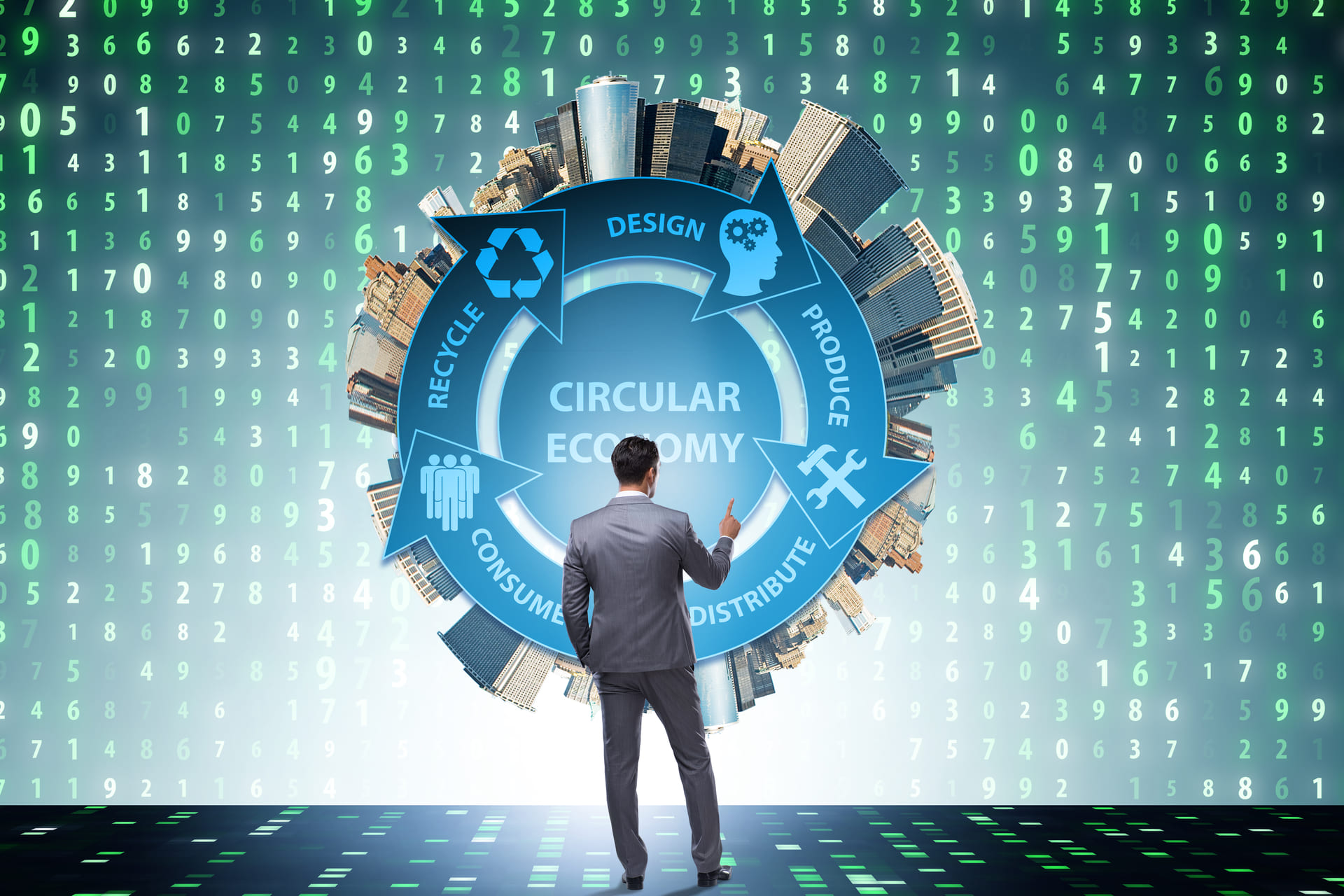Digital circular economy: the cornerstone to sustainability
Circular economy is vital for sustainable development and the climate goals. Digital technologies enable the transition in consumption and production patterns needed for the SDGs. Despite their existence, these technologies are not yet fully integrated into current business practices.

Harnessing digital technologies to upscale the circular economy
Digital technologies are an enabler for upscaling the circular economy, as they facilitate creation and processing of the data and information required for circular business models and meeting the complex demands of circular supply chains. Attaining circular goals calls for both optimisation of functionality and development of products-as-a-service. Making all this happen relies on digital technologies such as functional electronics, distributed ledger and the Internet of Things. The pursuit of dematerialisation can be closely related to the development of digital twins, artificial intelligence and virtual reality. At the same time, a circular economy provides the long-term sustainability vision necessary for upscaling the digital industry.
Enabling such digital transformation presents technology providers with many innovation challenges. It is also crucial that they understand their precise role in the transition towards a circular economy. In addition, they need to understand and mitigate the environmental and societal risks related to the implementation of a digital circular economy.
Circular business models make companies more resilient
A survey conducted by VITO, together with Circular Flanders, asked companies and organisations about their resilience to the impact of the COVID-19 crisis. The results showed that companies applying circular principles were less impacted by those not doing so. All linear companies reported shortages, whereas only two third of circular companies experienced problems, suffering less from shortages in raw materials, parts, stocks and decreased customer demand.
Digital technologies for circular value chains
Digital technologies enable new circular value chains. Digital solutions thereby provide an opportunity for capitalising on existing circular economy solutions and capturing additional value. With this comes the need for new circular business models such as Products as a Service (PaaS), sharing platforms and peer-to-peer interactions. Although there is general awareness of the need for a digital circular economy, too few connections exist between the digital and circular economy communities. Debate and interaction between these communities is therefore essential to start building bridges and form a solid basis for a common vocabulary.
We spoke with Thierry Geerts (CEO at Google Belgium and Luxemburg), Frederike Krebs (Advisor Technical, Environmental and Sustainability Affairs at Mechanical Engineering Industry Association), Holger Berg (Co-Head Digital Transformation at Wuppertal Institute) and Eivind Kristoffersen (Research scientist at SINTEF), asking them: How can digitalisation boost the circular economy? Why do we need a smart circular economy framework?
We also worked closely together with experts from research and technology organisations that are part of ECERA, the European Circular Economy Research Alliance. ECERA is a voluntary collaboration network that aims to strengthen and integrate scientific knowledge and expertise in the field of circular economy from an interdisciplinary perspective.
ECERA provided us with a white paper on the digital circular economy, through which we aim to strengthen the link between the digital and circular economy expert communities.
Digital technologies and novel data sources
Circular business models have a stronger need for data than linear models. Digital technologies, meanwhile, enable access to a broad range of novel data sources and provide transparent insights into the value chain. This creates opportunities for new business approaches and circular management of materials and products.
We need to think beyond current needs. We need to explore options enabled by digital technologies such as artificial intelligence, big data, blockchain and earth observation.
A perfect conversation to have with Els Knaeps (Expert at VITO), Paul Corman (Digital Strategist at Adobe), Raik Kulinna (Global Lead for Waste, Recycling and Environmental Services at SAP) and Marko Vujasinovic (Senior Consultant at Innova).
Digital twins of biological cycles
Digital technologies are already being applied in farming and biological material cycles. Examples of such applications need to be explored and discussed in more detail to understand how they could be transferred to the technological cycle of materials. In many cases, discussions about circular economy focus on the technological cycle while forgetting about the biological cycle. That needs to be reversed, exploring how digitalisation can link the two wings of the butterfly diagram.
We turned to Bryton Shang (CEO at Aquabyte), Bianca Lind (Teamleader Sustainability at Veravis) and Hui Cao (Head of Strategy and Policy at Huawei) for inspiration.
Smart connections between the Green Deal and the European Industrial Strategy
How will digitalisation enable a more circular economy and a more sustainable society? To examine this, we took a look into the connections between the European Green Deal and the European Industrial Strategy. Both of these key policy documents for the post-coronavirus period are driven by the Circular Economy Action Plan and the Digital Europe Programme.
Here, you can see the insightful discussion which took place between key players from the industry and the European Commission, involving Karl Vrancken (Research Manager Sustainable Materials at VITO), Signe Ratso (Deputy Director-General R&I at the European Commission), Holger Berg (Co-Head Digital Transformation at Wuppertal Institute), Massimo Gasparon (Innovation Director at EIT RawMaterials), Henning Ohlsson (Director Sustainability at Epson), Ernesto Ciorra (Chief Innovability Officer at ENEL) and Walter Weigel (Vice-President of the European Research Institute at Huawei).
Envisioning the future of digital circular economy
Circular economy and innovation go hand-in-hand. Innovation therefore has to be circular in nature. It is also clear that companies can only contribute to circularity if they make themselves part of a circular value chain.
Circular companies are aware that their products contain raw materials they’ll also need in the future. They use functional electronics, not to make products more flashy, but to make them more sustainable. They have a datacentric company culture and circularity is included in the C-level strategic agenda. Follow-up, management and communication around sustainability and circular performance is integrated in the company’s ERP system. Circular companies design products for longer product life and repairability and use modular and standardised components. They have a 10-year vision of value chain dematerialisation and the introduction of products as a service.
In the digital circular economy, data are shared in an open space with due regard to ownership, privacy and accessibility. Formats and protocols are standardised and interoperable. While users have control over the data generated through their usage behaviour, products have digital twins and material passports in order to optimise their trajectory along the value chain.
Digital products typically use a variety of critical raw materials, while current sustainability strategies in the digital sector mainly focus on energy efficiency and product lifetime (mostly battery lifetime). Increasing pressure on raw material supplies, however, means it is essential to plan ahead and substantially increase dematerialisation and urban mining efforts.
Circular economy strategies, therefore, need to reduce the digital sector’s dependency on imported and critical raw materials. With this in mind, we must take urgent action on modular design and standardisation of electronic equipment, together with functionalisation, tracking and tracing of digital products.
The COVID-19 crisis has shown that we are too dependent on material imports. More of the material for this digital circular economy needs to come from local sources. Urban mining needs better tracking, collection and sorting of materials based on machine learning. One of the main challenges is making sure the introduction of digital tools and electronics does not use more material than necessary.
